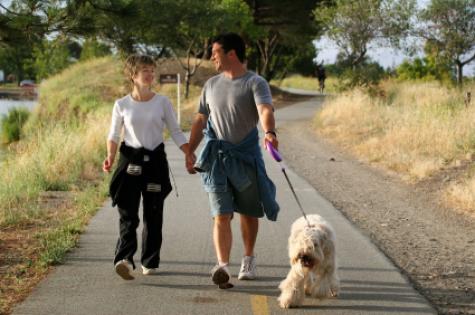Just as people have to watch their weight so, too, do our dogs. In fact, vets are becoming concerned about the increasing incidence of overweight dogs especially amongst those who are at home by themselves all day and who live an inner city apartment life.
“Many of the clients I see are overweight and do not have sufficient muscle tone because their owners simply don’t exercise them,” an inner city vet in Sydney, named John, told us.
“Their owners exercise for themselves by going to the gym or a class, and then they’re out at work all day. The dog can be lucky to get five minutes outside on the lead in the morning and evening – let alone a decent run around for 30 minutes two times a day.”
So how can you tell if your dog is overweight?
- Feel around his ribs and spine. You should be able to locate both, with only a thin layer of fat separating skin from bones. If you are unable to find the ribcage, you have an overweight dog.
- Viewing the dog from above, you should be able to see a moderate narrowing at the waist just past the ribcage.
- A large and drooping abdomen is another sign that your pet is overweight.
- A bulging line from the ribcage to the hips also indicates an overweight dog.
John says it’s worth asking your dog’s vet to assess his size at every check-up and to ask what his optimal weight should be on reaching maturity. Overweight dogs are prone to knee injuries, pancreatic issues, liver disease, heart problems, trouble cooling off, snoring, and more.
Here are John’s tips for getting the weight down on your dog, or helping to maintain it at the right level.
1. Talk to your vet.
Check that your dog isn’t overweight because of an underlying medical condition. It’s very rare, but it’s always worth checking.
2. Move.
A good starting point is a regular walk around the nearest park or around the streets where you live. Rainy days or cold days are no excuse. It won’t matter if your dog gets wet – other than when he returns home and shakes himself – and if you live in a really cold climate, you can let him use a dog coat. But the truth is, there’s very few places in Australia where dogs need one.
I recommend a minimum of 30 minutes a day (15 minutes twice a day) or, preferably, up to 60 minutes (30 minutes twice a day). If you really cannot get outside with him, then make sure he has at least 30 minutes of running around inside with your attention through some sort of game. This is to stimulate him physically and mentally.
3. Portion control.
Minimise the treats you give your dog, make sure they’re dog treats and use them for rewards – not because he’s look cute and pathetic and feels he needs something. Treats for dogs are like treats for humans: they’re okay in moderation, and as long as they’re healthy. Whatever you do, do not given them human treats such as cakes, biscuits and especially chocolates – they are simply bad for them.
4. Avoid human foods high in fat, sugar, or sodium.
The last thing on anyone’s to-do list is an emergency visit to the vet due to pancreatitis. Foods that are fried, oily, or greasy (chicken, turkey, ham, beef bones, gravy, stuffing, pastries, rolls, cheese, and other starchy or rich foods and desserts) are all culprits and should be avoided. Never allow dogs to have grapes, raisins, chocolate, caffeine, or alcoholic beverages. To keep dogs lean, it is important the entire family and those visiting know the rules.
5. Each family member must be on board.
Your dog’s health depends upon everyone working together. That means no feeding your dog after school, in secret, or under the table at dinner time. I always recommend dogs eat in a separate place and are not around when their owners are eating.


















__small.png)










